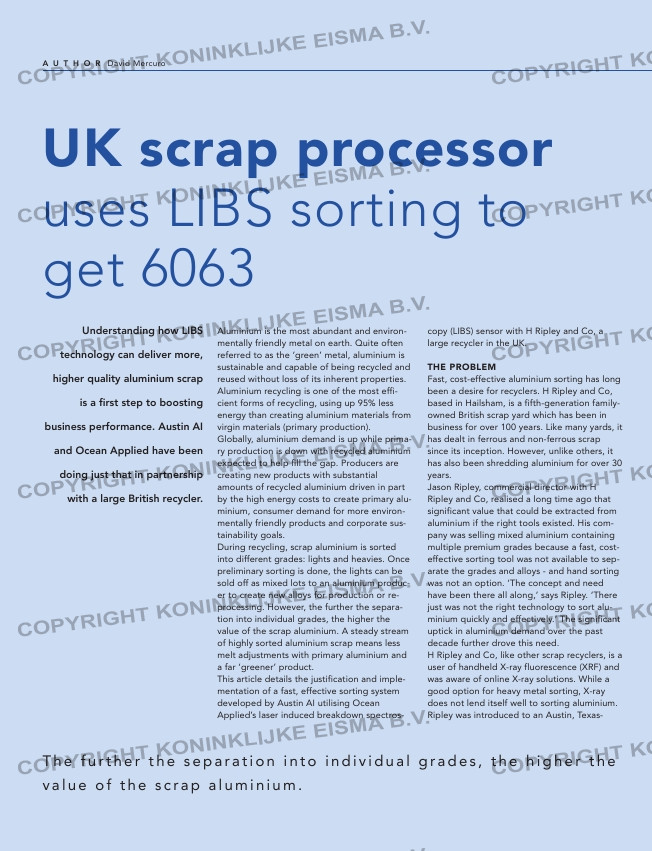Page 34 from: Recycling International – July/August issue 2023

UK scrap processor
uses LIBS sorting to
get 6063
Understanding how LIBS
technology can deliver more,
higher quality aluminium scrap
is a first step to boosting
business performance. Austin AI
and Ocean Applied have been
doing just that in partnership
with a large British recycler.
Aluminium is the most abundant and environ-
mentally friendly metal on earth. Quite often
referred to as the ‘green’ metal, aluminium is
sustainable and capable of being recycled and
reused without loss of its inherent properties.
Aluminium recycling is one of the most effi-
cient forms of recycling, using up 95% less
energy than creating aluminium materials from
virgin materials (primary production).
Globally, aluminium demand is up while prima-
ry production is down with recycled aluminium
expected to help fill the gap. Producers are
creating new products with substantial
amounts of recycled aluminium driven in part
by the high energy costs to create primary alu-
minium, consumer demand for more environ-
mentally friendly products and corporate sus-
tainability goals.
During recycling, scrap aluminium is sorted
into different grades: lights and heavies. Once
preliminary sorting is done, the lights can be
sold off as mixed lots to an aluminium produc-
er to create new alloys for production or re-
processing. However, the further the separa-
tion into individual grades, the higher the
value of the scrap aluminium. A steady stream
of highly sorted aluminium scrap means less
melt adjustments with primary aluminium and
a far ‘greener’ product.
This article details the justification and imple-
mentation of a fast, effective sorting system
developed by Austin AI utilising Ocean
Applied’s laser induced breakdown spectros-
copy (LIBS) sensor with H Ripley and Co, a
large recycler in the UK.
THE PROBLEM
Fast, cost-effective aluminium sorting has long
been a desire for recyclers. H Ripley and Co,
based in Hailsham, is a fifth-generation family-
owned British scrap yard which has been in
business for over 100 years. Like many yards, it
has dealt in ferrous and non-ferrous scrap
since its inception. However, unlike others, it
has also been shredding aluminium for over 30
years.
Jason Ripley, commercial director with H
Ripley and Co, realised a long time ago that
significant value that could be extracted from
aluminium if the right tools existed. His com-
pany was selling mixed aluminium containing
multiple premium grades because a fast, cost-
effective sorting tool was not available to sep-
arate the grades and alloys – and hand sorting
was not an option. ‘The concept and need
have been there all along,’ says Ripley. ‘There
just was not the right technology to sort alu-
minium quickly and effectively.’ The significant
uptick in aluminium demand over the past
decade further drove this need.
H Ripley and Co, like other scrap recyclers, is a
user of handheld X-ray fluorescence (XRF) and
was aware of online X-ray solutions. While a
good option for heavy metal sorting, X-ray
does not lend itself well to sorting aluminium.
Ripley was introduced to an Austin, Texas-
based company, Austin AI, by one of his cus-
tomers, a large UK extrusion ingot and sheet
ingot production. This company had had suc-
cess with Austin AI’s solution and urged him to
investigate it further.
SENSOR SORTING TECHNOLOGY
Austin AI ceo Rick Comtois is a veteran of ele-
mental analysis and has been focused on online
sensor sorting technology for over 20 years.
Having previously implemented numerous units
based on both nuclear magnetic resonance
(NMR) and XRF technology, Comtois shifted his
focus to LIBS in 2014. He says LIBS technology
offers unparalleled light element technology
that is not feasible with other methods.
The company’s interest in light element sorting
solutions led to a relationship with Hydro
Aluminium in which Austin AI built a sorting
system for recovering aluminium 6063 from
construction and demolition (C&D) material.
Aluminium scrap yard.
A U T H O R David Mercuro
T h e f u r t h e r t h e s e p a r a t i o n i n t o i n d i v i d u a l g r a d e s , t h e h i g h e r t h e
v a l u e o f t h e s c r a p a l u m i n i u m .
34-35-36-37_oceaninsight.indd 34 05-07-2023 11:56



